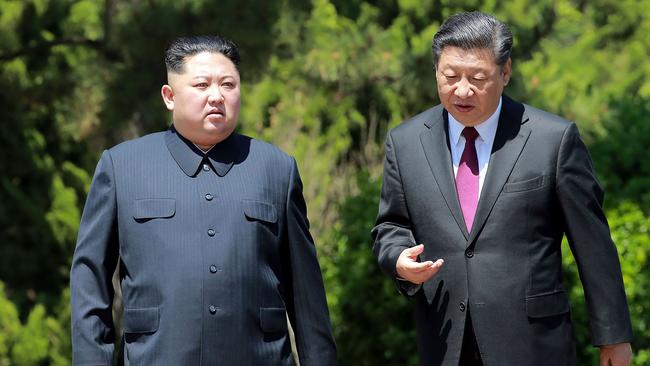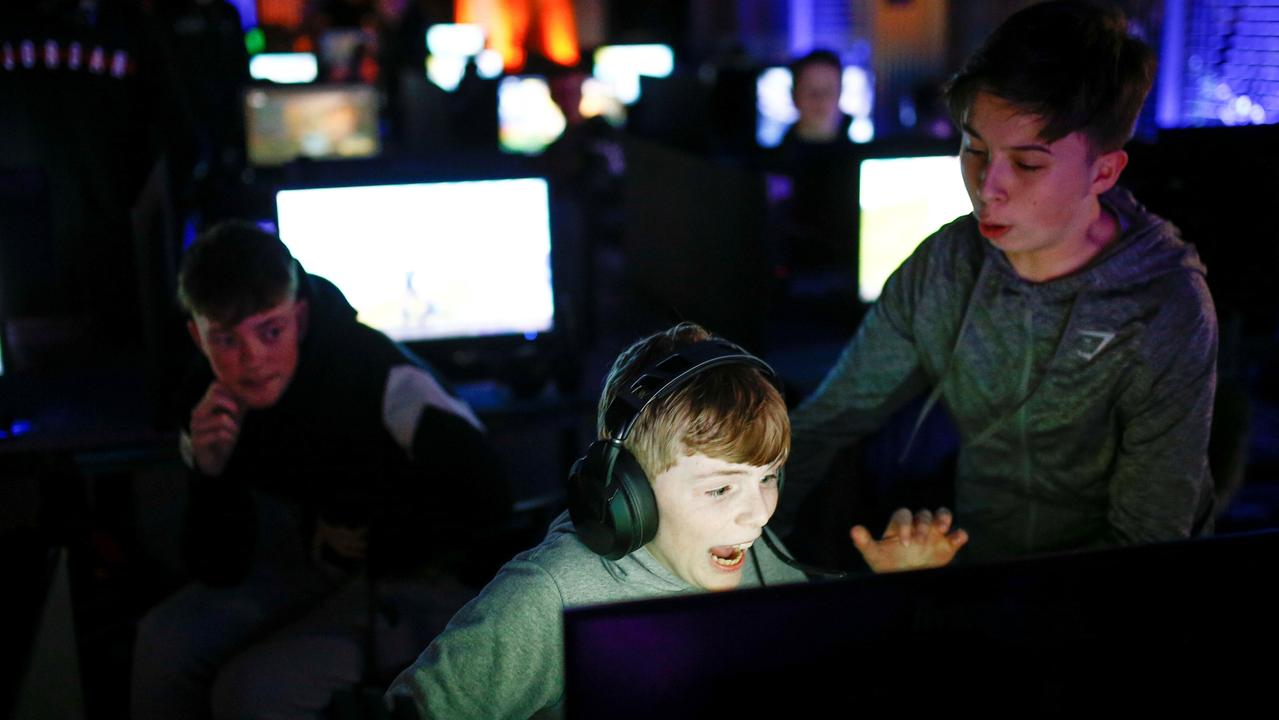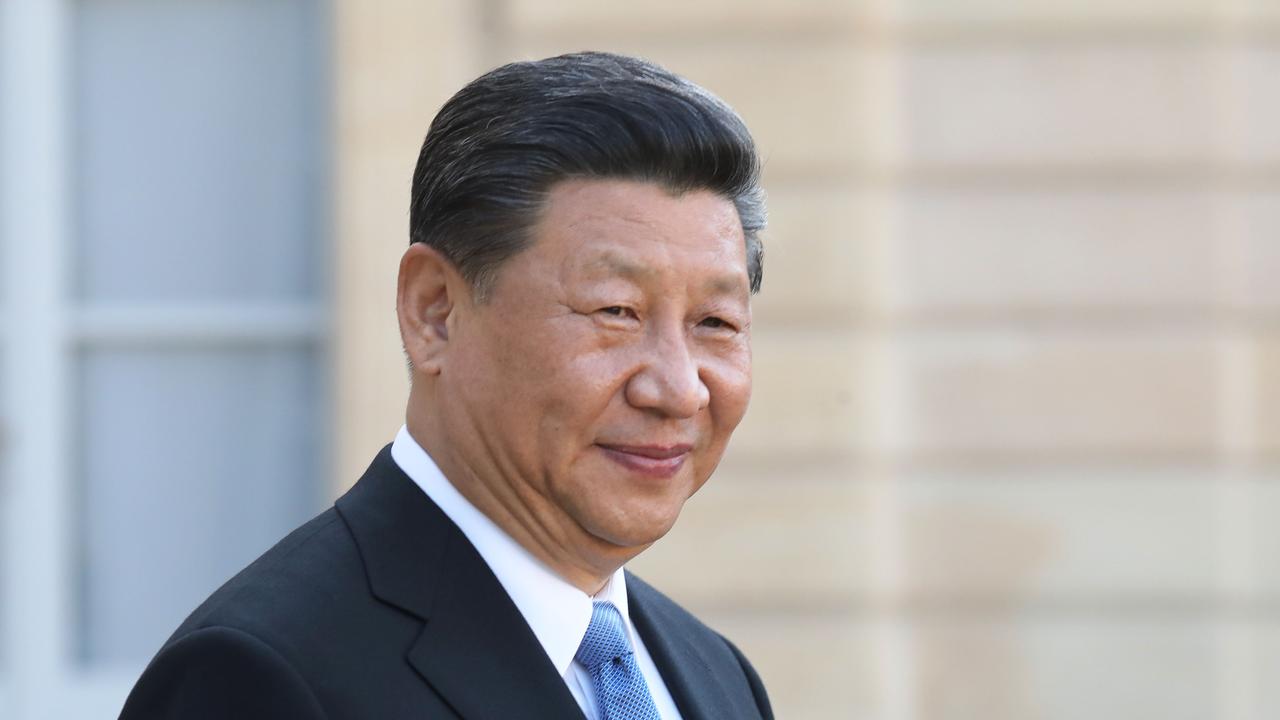Kim Jong-un meeting with Donald Trump has the world’s attention
The North Korean leader seizes his moment ahead of Trump summit.

If North Korea’s propaganda machine is to be believed, “Supreme Leader” Kim Jong-un comes from a long line of mythical heroes.
His grandfather was the greatest genius to have walked the earth. His father was a prodigy in all areas, proving himself a crack pistol shot — on horseback — by age five.
So International Olympic Committee president Thomas Bach was pleasantly surprised during a March meeting in Pyongyang when Kim broke the ice with a self-effacing remark about his own diminutive size and portly physique.
“Even if it may not look like it, I love to play sport, and especially basketball,” Bach, a former Olympic fencer, says Kim told him.
Kim has a way of overturning expectations. When he inherited power in North Korea in December 2011, expert opinion was he’d be toppled or killed within a year. Filmed red-faced and sobbing at his father’s wake, the pudgy would-be dictator in his late 20s didn’t seem up to the Darwinian task of extending the bloody Kim dynasty to a third generation.
Six years on, he is a bona fide 21st-century tyrant prepping for a planned meeting tomorrow with US President Donald Trump — a summit Kim’s father and grandfather only dreamt about. Along the way, he acquired intercontinental ballistic missiles faster than many scientists thought possible, and threatened to use them on US cities during a harrowing nuclear standoff.
At home, he is digging in for a long rule by replacing older apparatchiks with younger ones loyal to him. He has killed rival family members, staged public executions and is keeping about 100,000 people in gulags, say UN investigators who accused him in 2014 of crimes against humanity. He has had more defence ministers than in all North Korea’s previous 50 years.
Once seen as a sadistic recluse who lacked the confidence to meet a single foreign leader during his first six years in power, Kim is now on a diplomacy blitz. Since March he has met South Korean President Moon Jae-in and China’s Xi Jinping twice, and proposed a summit with Trump — all while gaining a reputation as a sure-footed host who toasts guests with fine wines and softens his fearsome reputation with humour.
While the North Korea nuclear crisis is still unfolding and Kim’s future is far from certain, the man Trump is gearing up to meet has turned out to be a far more calculating, brutal and ambitious operator than was once believed, raising the challenges for Washington in the years ahead.
“People who have assumed for years that he was some punk kid with a real mean streak put in a position of power are now finding out that he has a lot more capabilities than that,” says Ken Gause, who follows North Korea’s leadership at CNA, a US think tank.
IOC head Bach’s encounter with Kim at a sports complex in Pyongyang came just days after the dictator had travelled by armoured train to Beijing to meet Chinese leader Xi, and just before his secret Easter weekend meeting with CIA director Mike Pompeo, now US Secretary of State.
After a private conversation in which Kim spoke without notes or aides, the North Korean ruler led Bach into a stadium where about 100,000 North Koreans were awaiting a women’s soccer game. The huge crowd applauded Kim’s arrival for what seemed like 15 minutes before the game began, an official there says. Kim ended the week with a concert by visiting South Korean K-pop musicians.
With his hair slicked into an anvil-like pompadour, Kim appears at least a decade older than he is, and so much like a propaganda poster of his grandfather Kim Il-sung, worshipped as North Korea’s founder, that some observers suspect he had plastic surgery to that end.
US intelligence officials concede they lacked a full picture of Kim, the obscure third son of Kim Jong-il, when he emerged as successor. Perhaps more important, Kim is evolving on the job, these officials say. They describe his string of diplomatic meetings in the run-up to the possible Trump summit as the “paragon” of strategic foreign affairs planning.
In the meetings, Kim is tailoring his posture for effect, seeking to play the interests of China, South Korea and the US against each other to his advantage, says Brookings Institution senior fellow Jung H. Pak, a former CIA senior analyst for North Korea.
In late March, when Kim went by train to China to improve ties with its leader, Xi, a linchpin for sanctions enforcement, Kim was filmed taking notes like a schoolboy as the older man lectured.
Pompeo said his meeting with Kim a few days later was “productive” and a sign that there was “a real opportunity” for a historic disarmament deal.
In South Korea, where Kim is often portrayed as a bloodthirsty delinquent, he smiled, clasped President Moon’s hand and promised an era of peace during their live April summit. Kim even vowed to reset North Korea’s clocks to normal Korea time after turning them back 30 minutes in 2015.
After the summit, 78 per cent of South Korean respondents said they now viewed Kim positively, according to a poll by South Korea’s MBC News, compared with approval ratings of as low as 10 per cent in previous polls. “Once we start talking, the US will see I am not the kind of person to launch nukes,” Kim told Moon, South Korea said.
Trump administration officials credit tough economic sanctions and the threat of US military strikes with pressuring Kim to come to the negotiating table, raising hopes for nuclear detente and a peace treaty to end the 1950-53 Korean war.
“He is very young, so he presumably wants to be around for a long time and maybe wants to, you know, have some kind of different future for his country,” says Susan Thornton, an East Asia expert who serves as acting assistant secretary of state.
South Korean conservatives and US hawks say Kim has no intention of giving up his weapons, a move he likely equates with suicide. Instead, his charm offensive is meant to reduce the chances the US will attack, persuade China to loosen sanctions enforcement and get South Korea’s progressive government to provide him with food and other aid.
Long term, he wants to drive a wedge between the US and South Korea, and perhaps one day unify the Korean peninsula on his terms, these sceptics say.
US officials say they are wary. “No one in the Trump administration is starry-eyed about what’s happening here,” says national security adviser John Bolton, a long-time North Korea hardliner.
North Korea has broken four nuclear deals since 1992, while receiving $US1.3 billion in food and oil from the US
Getting a read on Kim is difficult because North Korea is arguably the world’s most secretive nation, all but cut off from global phone lines and internet, and obscured behind a kaleidoscope of propaganda.
North Korea kept the death of Kim’s father, Kim Jong-il, a secret for two full days without the US or South Korean intelligence services figuring it out. Even the younger Kim’s birth year, believed to be 1984, is unconfirmed.
Pyongyang is a city of pastel buildings, huge Kim murals and towering Kim statues. Propaganda music and speeches echo from outdoor speakers. Tourists, businesspeople and journalists who travel there on closely monitored trips see only fragments but never the big picture.
But the capital is changing under Kim. In his recent visit, Bach saw a city that appeared more polished and vibrant than what he remembered from a previous visit two decades before. Once grey and drab, the city now features newer buildings. Passers-by appeared better dressed, wearing more colours. Where officials once read prepared statements to him, they now spoke extemporaneously.
“You get a glimpse,” Bach says.
In the absence of data, some researchers turn to history for insights. Like all tyrants, going back to the fourth century BC tyrant of Syracuse who lived under the proverbial sword of Damocles, Kim rules with the knowledge he may be killed at any moment, many experts believe.
Others search for clues in sources such as the video of Kim’s April meeting with South Korea’s president: Kim seemed winded after strutting across the demilitarised zone line. Was he nervous or out of shape?
South Korean envoys who visited him in February told reporters he appeared “relaxed” and “confident”, jokingly apologising for waking up South Korea’s President with crack-of-dawn missile tests, and musing about his reputation as a global pariah.
Others are repulsed by the idea that Kim is anything more than a psychopath.
“People are going to see him and say, ‘Wow, he is acting like a normal person.’ But he is not a normal person. This is the guy who kills his own family,” says Go Myong-hyun, a North Korea researcher at the Asan Institute for Policy Studies in Seoul.
To instil fear, Kim uses brutal practices such as public executions with anti-aircraft guns and imprisoning three generations of a dissenter’s family, according to Greg Scarlatoiu, who runs the Committee for Human Rights in North Korea, a Washington, DC-based advocacy group.
“This is a highly paranoid regime built on an us-versus-them mentality, where the Kims truly fear their own people,” says Scarlatoiu, who grew up under Romania’s brutal Nicolae Ceausescu.
Kim threatened terrorist attacks to prevent Sony Pictures from releasing the 2014 film The Interview, in which he is killed by buffoonish reporters. Soon after, hackers broke into Sony’s servers and put embarrassing internal email and unreleased films online. US officials say North Korea is responsible.
“He spent six years pushing the envelope without any punishment,” says Pak, the former CIA analyst. “Once your confidence grows and failure is not in your vocabulary, your ambitions evolve.”
Educated under an alias at posh Swiss schools, the Chicago Bulls-loving youngest son of Kim Jong-il and a Japanese-born dancer was a surprise choice to outsiders. His existence wasn’t even mentioned in state media until 2010.
Though he’d been dressed up as a general as a little boy, Kim hardly seemed to have the resume to run a tyrannical regime. While North Koreans starved, the Kims dined on imported sushi, shark fin soup and delicacies including Uzbek caviar, according to Kenji Fujimoto, the alias of a Japanese sushi chef who worked for the Kims.
At 13, Kim started smoking Yves Saint Laurent menthol cigarettes, among the world’s most expensive at $US55 a pack, Fujimoto said in a televised interview. Kim told Bach that he had visited the Olympic museum in Lausanne, Switzerland, twice as a boy.
Meantime, North Korea was a mess. Founded as a Soviet-backed satellite after World War II, the isolated nation was struggling to emerge from a famine that killed about one million in the 1990s.
The Kims held power through the brutal enforcement of a family personality cult, even though average North Koreans who survived the famine were becoming aware that life was better elsewhere thanks to surging defections.
Kim’s overseas schooling may have afforded him some advantages. He has seen far more of the West than his father, and may speak some German and English.
Western experts believed Kim would rule as a weak figurehead under the care of a regent, his uncle by marriage, and powerful generals. But more than his father, Kim has shown a willingness to kill family.
In 2013, he ordered the execution of his uncle, leaving little question who was in charge.
Last year Kim ordered his half-brother and critic, Kim Jong-nam, killed with VX nerve agent in a Malaysian airport, US officials say. The victim carried atropine, a possible VX antidote, suggesting he lived in fear of a foretold fate.
In five years Kim executed or purged about 340 officials, according to South Korea’s intelligence service.
“At first we were all perplexed why he was chosen,” says Andrei Lankov, a North Korea expert at Kookmin University in Seoul. “But then we realised that he is an efficient, rational, Machiavellian dictator, and only an efficient, rational, Machiavellian dictator can rule North Korea, otherwise it will collapse.”
One month before Kim took office, Libyan dictator Muammar Gaddafi, who had dismantled his own nuclear program in 2003 under US pressure, was killed by a NATO-backed insurgency.
To avoid a similar fate, Kim began a policy of byungjin, a two-pronged strategy of “irreversibly” completing the nuclear program to deter foreign intervention, while reviving the economy to bolster his legitimacy, observers say.
To improve food supply, Kim de-collectivised some farms and allowed black-market trading in food and other goods to flourish.
To raise living standards for loyal elites, he imported about $US2bn of luxury goods including whiskey and electronics in his first three years, according to Chinese trade data. He built attractions such as a water park, a dolphin show and a ski resort.
Though the measures helped achieve 4 per cent growth, they also have made North Korea more vulnerable to economic sanctions.
North Korea had wanted nuclear weapons for 60 years when Kim took power but managed to detonate only two embarrassingly low-yield bombs.
A crucial sign Kim was serious about completing the task came just four months into his rule, when he ripped up a “Leap Day” disarmament deal to receive food aid he’d agreed to two weeks earlier. Instead, he declared he would launch a rocket into space — a key step towards building a ballistic missile.
It didn’t go well. The rocket broke up after 90 seconds and splashed into the ocean west of Seoul. Kim, who had invited the foreign press to view the launch pad, had failed publicly.
Instead of covering up the mishap at home, as many foreign observers expected, Kim allowed his state media to report the mishap. He admitted the failure and urged his scientists to keep trying.
“It showed the more modern, flexible management style that you need for innovation, the difference between a system where everyone is afraid of failure, and one where you learn from your mistakes, fix it and get better,” says John Delury, an expert on North Korea at Yonsei University in Seoul who is writing a book about the Kims.
One month later, Kim added the term “Nuclear State” to the definition of North Korea in its constitution. By the end of that year, the North Korean missile engineers were ready to attempt to launch the rocket again — and it worked.
In September he detonated North Korea’s most powerful nuclear device. In November North Korea launched the Hwasong-15, an intercontinental missile that flew for 53 minutes with a range of 13,000km — enough to hit anywhere in the US. Though doubts remain, Kim declared he had a achieved a “state nuclear force”.
“Our republic has at last come to possess a powerful and reliable war deterrent, which no force and nothing can reverse,” Kim said in his annual January speech, wearing a business suit instead of a Mao outfit. “The nuclear button is on my office desk all the time.”
Then he offered to deal.
John Lyons
The Wall Street Journal



To join the conversation, please log in. Don't have an account? Register
Join the conversation, you are commenting as Logout